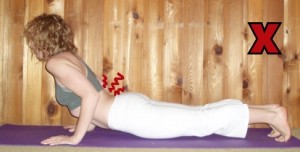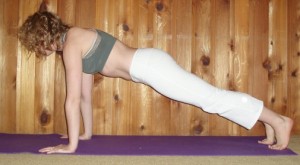Yoga teachers often avoid getting their yogis to push up from their bellies to plank pose, because it is so challenging to do correctly. Yogis must have the triceps strength to push the whole body, as a unit, up into plank, and they need the core strength to be able to stay flat as a board from the shoulders all the way down to the heels. If a yogi with weak triceps or core muscles is determined to push up, they will often compensate by letting the hips sag down as they lift the shoulders. This puts the low back in a dangerous position where it may easily be injured. Since the core muscles are not strongly contracted in this position, the weight of the legs and hips hangs off the connective tissue in the low back instead of being supported by the muscles.
Here’s a way to avoid putting the low back at risk; instead of leading with the shoulders, we’re going to lead with the hips. Start laying on the stomach, hands palms-down underneath the shoulders with the fingers spread. Squeeze the elbows into the sides of the body. Now tuck the toes under. As you inhale, contract the quads (muscles in the front of the thighs), hip flexors (muscles in the front of the hips), and lower abdominal muscles so that the knees and hips lift off the floor.
Looking at the two photos above, you may think they put the low back in equally awkward positions. The difference is, in the second picture, the core muscles are active, which takes the strain out of the connective tissue in the low back.
To help out the core muscles, step the toes forward just a touch. The feet shouldn’t be so far forward that the hips stick up when you reach plank, but if they’re too far back, it makes the hips more likely to sag at you push up. You should feel like you have a strong base of support. Now, as you exhale, squeeze the elbows in to the sides of the body and lift the chest off the mat, coming into chuttarunga.
If the triceps are weak, the tendency is to bow the elbows out to the sides or slide the shoulders up toward the ears. Try to avoid this. Use the chest, shoulder, and upper back muscles to keep the elbows tight. Use the upper back muscles to slide the shoulder blades down the spine toward the hips. Keep the abdominals contracted, and continue straightening the arms until you’re all the way up in plank. Breathe.
Using this progression to transition from the belly to plank pose makes lower back injuries much less likely.



